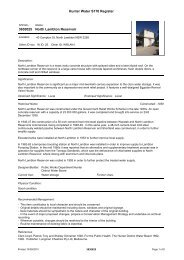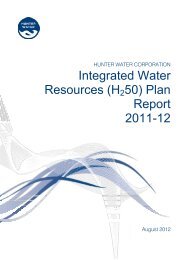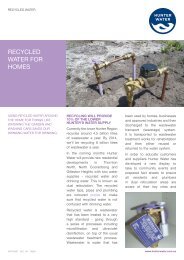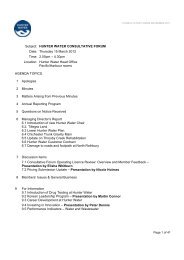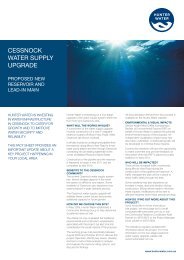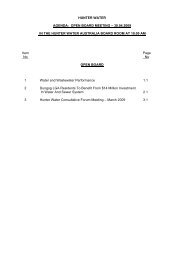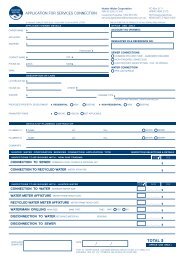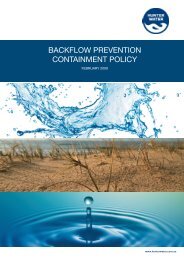Catchment Management Plan - Hunter Water
Catchment Management Plan - Hunter Water
Catchment Management Plan - Hunter Water
Create successful ePaper yourself
Turn your PDF publications into a flip-book with our unique Google optimized e-Paper software.
“Preventive measures by their1.6 <strong>Catchment</strong> management environmental stewardship in catchmentsand climate changehas broad environmental and socialnature should be applied as close tooutcomes, including mitigating andthe source as possible, with a focus “According to many experts, water managing the impacts of climate change.on prevention in catchments rather and its availability and quality will1.Opportunities for climate changethan sole reliance on downstream be the main pressure on, and issues mitigation in catchmentscontrol.” 1for, societies and the environmentThere has not yet been a unilateralunder climate change.” - IPCC 2agreement on the depth of cuts inThe barriers that reduce the risk of agreenhouse gas (GHG) emissionswater quality incident are listed at thenecessary to mitigate the risk ofThere is strong scientific evidencetop of Figure 3 (below). The variousclimate change. Despite this, <strong>Hunter</strong>for human induced climate change.protective measures that underpin<strong>Water</strong>’s GHG and Energy <strong>Management</strong>It is recognised that Australia - andthem are listed alongside.Policy commits to no net annual GHGin particular the water industry - isincrease from 2008-2013 and catchmentvulnerable to the impacts of climateThe green shading that predominatesmanagement activities provide achange. There are two ways to manageon the right of the table indicates thatmechanism by which <strong>Hunter</strong> <strong>Water</strong> canthe risk of adverse impact, either:1barriers are generally robust for <strong>Hunter</strong>meet these targets. Vegetation within<strong>Water</strong>’s treatment and supply system.catchments store significant carbon• attempt to reduce or halt the changeIn contrast, catchments, and to somestocks; maintaining these and pursuing(climate change mitigation) orextent dams, provide ‘developing’opportunities for carbon sequestration• live with its effects (climate changeprotection to drinking water quality.will have dual benefits of mitigationadaptation).It is evident from the table that we canagainst climate change and improving theimprove the integrity of our catchmentsquality of water through natural filtration.In practice, a combination of substantialin terms of minimising risks to sourcecuts to greenhouse emissions andwater quality.<strong>Hunter</strong> <strong>Water</strong> has a significanteffective adaptation policy will beopportunity to leverage catchmentrequired to combat climate change.management and climate change works<strong>Hunter</strong> <strong>Water</strong> recognises that goodPROTECTIVEBARRIERSMEASURESCATCHMENTS RESERVOIR TREATMENT DISINFECTION CHLORINE CLOSEDSYSTEMStools for identificationof water quality riskslegislativecontrolseffective stakeholderrtelationshipsmonitoring programresearchroutine inspectioncommunity educationN/Aemergency responseplansFigure 3: Barriers to protect drinking water quality. Efficacy of each barrier is indicated by green shading (robust), orange (developing)1 NHMRC and NRMMC (2004) Australian Drinking <strong>Water</strong> Guidelines, 20042 Intergovernmental Panel on Climate Change Technical Paper VI - June 2008CATCHMENT MANAGEMENT PLAN . ssS . 001 . JUNE20108




